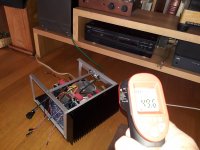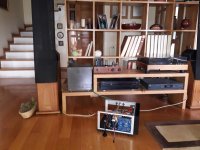Finally after long time I decided to build my 200W mosfet amp, but the balanced H-bridged version, actually CMA VFA.
I used my PS regulator and 1000VA transformer.
Not sure what Richard version is using for the power supply and what for balanced inputs.
Attached photo shows the heath sink temperature (only one channel for the moment) after one hour playing at quite high level. For sure not so hefty heath sinks and the box built as Richard ones.
I used my PS regulator and 1000VA transformer.
Not sure what Richard version is using for the power supply and what for balanced inputs.
Attached photo shows the heath sink temperature (only one channel for the moment) after one hour playing at quite high level. For sure not so hefty heath sinks and the box built as Richard ones.
Attachments
You have a Sentec turntable? 8-o
//
Yes, with Infinity black widow arm, direct drive, the wood plating added by myself. Other one I have is BIX with belt drive. I am sentimental.
Last edited:
As to whether its a CMA, CFA or VFA who cares and why dwell on it?
I personally don’t care too, until “CMA” is used and abused as being the secret sauce of audio performance, without any technical justification, other than “because I say so”. Lack of understanding basic concepts, or yet another self promoting tactic, or a combination thereof, that is the question.
Finally after long time I decided to build my 200W mosfet amp, but the balanced H-bridged version, actually CMA VFA.
I used my PS regulator and 1000VA transformer.
Not sure what Richard version is using for the power supply and what for balanced inputs.
Attached photo shows the heath sink temperature (only one channel for the moment) after one hour playing at quite high level. For sure not so hefty heath sinks and the box built as Richard ones.
When i see that schematic i can only ask which part of the "lower part count design" was missing there?
At least I see one more guy who thinks that Denon cd players are good!
Finally after long time I decided to build my 200W mosfet amp, but the balanced H-bridged version, actually CMA VFA.
No shipping from Thailand yet?

When i see that schematic i can only ask which part of the "lower part count design" was missing there?
At least I see one more guy who thinks that Denon cd players are good!
I have Denon DVD-3910 too.😀
Last edited:
It appears to me that “current mode” is used by some high end audio priests as yet another buzzword, in fact blurring Gilbert’s definition (in the context of translinear principle) to the point of completely obfuscating any engineering meaning.
I agree, does simply degenerating an LTP make it current mode I don't think so. A little research showed that a non-slew limited VFA was published by Hearn in 1970, is this current mode?
But it does deflect conversation from the important things to minutae that don't really matter in the grand scheme, which is what the high end has been about for the last 40 odd years 🙂
TRUE!But it does deflect conversation from the important things to minutae that don't really matter in the grand scheme, which is what the high end has been about for the last 40 odd years 🙂
🙂When i see that schematic i can only ask which part of the "lower part count design" was missing there?
I opened the schematic, had a moment of stupefaction (white hole), tried to look at the feedback path to know if it is evil or holy ... and give-up with a feeling of infinite laziness, asking myself if the electrons trapped in this box had to undergo a special training to recognize their way.
Oh, Lord, what a work !!!
Now, I'm just waiting from Richard and Dadod to read listening impressions (flawed, sighted, subjective as it suits).
Last edited:
🙂))))))))))))))))))))))🙂
I opened the schematic, had a moment of stupefaction (white hole), tried to look at the feedback path to know if it is evil or holy ... and give-up with a feeling of infinite laziness, asking myself if the electrons trapped in this box had to undergo a special training to recognize their way.
I think that they tried to compete with Krell...
Last edited:
My son has been staying with me for a few months after returning from living in Japan for 10 years.
When he moves out in the next week or so, I have informed my wife that the room will be converted into a sound room - a place for hifi, CD's, vinyls, turntable and thick speaker cables etc where I will not be distracted. I want a cool space with audio man stuff all over the place like Michael Fremmer and those other guys at Stereophile. I'll be listening in the near-field, so will have Richard's approval 😉
I got the idea from my other son who also has a sound room. However, my daughter in-law has informed him that come the day, he will vacate the room for a junior Russell, no discussion.
When he moves out in the next week or so, I have informed my wife that the room will be converted into a sound room - a place for hifi, CD's, vinyls, turntable and thick speaker cables etc where I will not be distracted. I want a cool space with audio man stuff all over the place like Michael Fremmer and those other guys at Stereophile. I'll be listening in the near-field, so will have Richard's approval 😉
I got the idea from my other son who also has a sound room. However, my daughter in-law has informed him that come the day, he will vacate the room for a junior Russell, no discussion.
Cant-we, once for all, have here a serious analysis of this question, between gentlemen, out of any ego or religious attitude or preconception about this subject ?I agree, does simply degenerating an LTP make it current mode I don't think so. A little research showed that a non-slew limited VFA was published by Hearn in 1970, is this current mode?
Forgetting all the stupid questions of supposed audiophile fashions or names (to know what is a question of current or tension as this is only two points of view on the same phenomena ?)
Asked to Scott the question, in private because i'm really terrified by the behaviors of some contributors here.
I made some time ago, on my side, extensive experiments to try to understand better this question. Simulated and built two similar amps, one in CFA (or whatever name you want to put on it) and one with a LTP. Same OLG, same CLG. Apart the input stage, the two amps had the same gain stage and output stage. Working on impedance of the feedback path.
My conclusion (still waiting for Scott's answer to stay corrected) were the only difference I could find is:
LTP add a pole in the feedback path and can be considered equal to a CFA with a buffered feedback. (or the contrary ;-)
That I tried to timidly suggest with this little schema presented as a joke:
But nobody reacted.
Notice that, in the two cases, feedback signal is subtracted the same way: using a single transistor working in common emitter for the signal and common base for the feedback.
When he moves out in the next week or so, I have informed my wife that the room will be converted into a sound room - a place for hifi, CD's, vinyls, turntable and thick speaker cables etc where I will not be distracted. I want a cool space with audio man stuff all over the place like Michael Fremmer and those other guys at Stereophile. I'll be listening in the near-field, so will have Richard's approval 😉
.
If I could afford a house with a playroom for the kids+TV then the living room would become exactly that, but for two up listening. Two's company. Three needs a visit to the doctor 😛
I would like to add, at the destination of Dadod, that, despite or because its work is the exact opposite of my natural inclination (Simple is beautiful) he has all my deep admiration: I feel totally unable to achieve such an astonishing thing.🙂))))))))))))))))))))))
I think that they tried to compete with Krell...
As all my personal efforts consist to optimize the relative gains of current or voltage of each stage (once individually optimized), in order to reduce the overall distortion, and because it is enough so much work with few parameters, how to do-it with so many variables interacting with each others?
[edit]Why the hell am-I so serious, this morning ?
Last edited:
- Status
- Not open for further replies.
- Home
- Member Areas
- The Lounge
- John Curl's Blowtorch preamplifier part III


